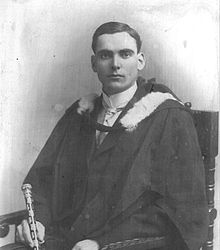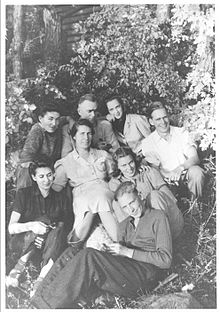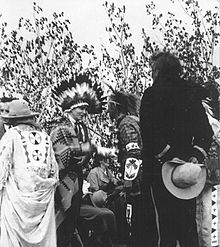- R. G. Ferguson
-
Dr. R.G. Ferguson Born 12 September 1883
Joliette, North DakotaRobert George Ferguson, O.B.E., B.A., M.D., LL.D., (12 September 1883 – 1964) was a pioneer in North America's fight against tuberculosis (TB) and the introduction of free treatment.[1][2]
As Medical Director, and later as General Superintendent of the Saskatchewan Anti-Tuberculosis League Canada, he achieved many firsts for the province, including
- first province in Canada to provide free treatment of tuberculosis
- first province to initiate a vaccination program for its sanatorium personnel and the native population
- first province to conduct tuberculosis surveys [3]
Furthermore, Dr. Ferguson was a pioneer in long-term BCG (Bacillus Calmette Guėrin) research, quite controversial at the time.
Contents
Biography
He was born 12 September 1883 on a farm near Joliette, North Dakota, where his parents had moved from Ontario. In 1903 the family moved to a homestead near Yorkton, Saskatchewan. "George's" education was interrupted following public school by a spell of homesteading on his own before starting high school in Winnipeg at the age of 20. At first he planned a career in the Church, and attended Wesley College (Methodist) at the University of Manitoba, carrying out mission field work in Alberta in 1908 and 1912. After earning a Bachelor of Arts degree, a Bronze Medal in Arts and being selected Senior Stick by classmates, his path changed and in 1916 he graduated in medicine, earning another Bronze Medal. In his final year of medical school he worked part time in a laboratory making typhoid vaccine for the Canadian Expeditionary Force. Dr. Ferguson's post-graduate work included training at the London Hospital in England, and at Harvard School of Medicine, Harvard University.
Ferguson married the former Helen Ross of Wynyard in 1916.
Medical Career [4]
Following his graduation Dr. Ferguson was appointed Assistant Medical Superintendent, Acute Infection Hospital, Winnipeg. From here he went to the Fort Qu'Appelle Sanatorium intending to stay for six months. He remained for 31 years. He was a skilled administrator with a knowledge of economics and the ability to analyze the dire challenge presented by rampant TB infection in the community. Native populations were particularly susceptible. In 1917 the Province of Saskatchewan had the nation's highest incidence of tuberculosis with a rate of 50 cases per 100,000 population.[5] Dr. Ferguson saw quickly that the only way to deal with this situation was to provide diagnosis, treatment and hospitalization at no cost to the patient. This was a huge political challenge. Dr. Ferguson persisted in his efforts, working patiently to gain support from TB sufferers, the public, members of the medical profession, and, last but not least, politicians. As one of three members appointed by the Provincial Government to form the Saskatchewan Anti-Tuberculosis Commission in 1921 he wrote the entire report. Nineteen of its 22 recommendations were implemented. Chief among them was making the cost of diagnosis and treatment of TB a public responsibility. Upon Ferguson`s death in 1964 then Saskatchewan Minister of Health Minister Allan Blakeney said, "The introduction of diagnosis and treatment of tuberculosis at public expense was one of the early and essential steps in developing a program of health services for all."[6]
In 1928 Ferguson gave a landmark presentation entitled "Tuberculosis Among the Indians of the Great Canadian Plains"[7] at the 14th Annual Conference of the National Association for the Prevention of Tuberculosis at British Medical House, London. It established him as an international authority on TB. Later on the same trip he attended the Council of the International Union Against TB (CIUA) where the double barred cross of Lorena was adopted as a symbol of the worldwide fight against TB.[8] A further achievement in 1928 was integration of the native population into the sanitorium. Saskatchewan, under Ferguson's guidance, was the first province by eight years to fully integrate the native population into sanatoria. Previously they were segregated.Ferguson found an ally in incoming Premier James G. Gardiner, and on 1 January 1929 the Saskatchewan Sanatoria & Hospitals Act was passed. Saskatchewan became the first province in Canada to make tuberculosis treatment free to all who needed it.
BCG Research[9]
At the time Dr. Ferguson began his career at Fort Qu'Appelle, BCG vaccination was, to say the least, controversial. This grew to a fever pitch in 1929 when 270 infants in Lubeck Germany were vaccinated with a vaccine which was supposedly BCG but which turned out to be virulent tubercle bacillus. Seventy seven children died of tuberculosis. The idea of introducing live tubercle into the human body was considered dubious from perspectives of both health and morality. However, the reality in 1926 was that natives were ten times more likely than non-natives to die from tuberculosis. And the risk of BCG vaccination was theoretical; not proven. Dr. Ferguson felt it was justified. He was so convinced of the value of BCG vaccination that he vaccinated his own children.
In 1932 Ferguson received approval to begin BCG vaccination of newborn infants in the Fort Qu'Appelle Health Unit, and an increase in his annual National Research Council (NRC) grant for BCG research which, remarkably, was renewed for 21 consecutive years. In collaboration with Austin Simes, a former classmate now working with native populations nearby, Ferguson embarked on a long-term studies of families of equal status with respect to living, social and economic conditions likely to impact health outcomes. In spite of some questions concerning "randomization", the Panel on Tuberculosis of the NRC Associate Committee on Medical Research recognized Ferguson's and Simes's study as "the most scientific trial of BCG yet made".
Legacy[10][11]
Statistics alone provide evidence of Dr. R.G. Ferguson's lasting impact on the fight against tuberculosis. In 1917 the Province of Saskatchewan recorded a rate of incidence of 50 per 100,000 of population. The death rate for Saskatchewan's native infants in their first year was even more appalling: in 1936 it was still 1,603 per 100,000. By 1948, the year Ferguson retired, the death rate was down to 17 per 100,000. These impressive numbers are the result of Ferguson's two-pronged attack. First, he established access to free diagnosis and treatment, and second, he established BCG as a safe and effective vaccination.
Statistics alone, however, do not measure Ferguson's full influence on public health policy. He charted a course that would not only guide the direction of treatment of tuberculosis, but that would inspire health coverage plans across the country for generations. In 1935, one of his contemporaries Dr. Norman Bethune, who himself had contracted tuberculosis, attempted unsuccessfully to organize a Montreal Group and extend this concept and introduce a free health care system across Canada.
On his retirement in 1948, the person voted through the English language branch of the Canadian Broadcasting Corporation to be "the Greatest Canadian", T.C. Tommy Douglas, who had been both Premier and Minister of Public Health from 1944–48, said of Ferguson:
“Not before in the history of this province has there been such a universal expression of regard for one man. Few men have the opportunity in their lifetime to give such service as Dr Ferguson has to his generation and to his age. Still fewer would be so successful in rising to the opportunity.” [12]
Paradoxically, Ferguson's legacy was articulated as early as 1917 in his speech on the opening of the Fort Qu'Appelle Sanitorium:
"When we think of the future of this institution we do not think of its building and equipment, but rather of an idea, a force, a group of associations and a locality with its hopeful traditions, glowing with prestige and confidence in the cure of the disease. We would like to think of it as a medical centre, where is available every facility for the diagnosis and treatment of tuberculosis, where a sick man may get every chance to regain his broken health and return to a sphere of usefulness as a citizen. We want it to be an educational centre where the facts about a disease are being accumulated for public use; a centre where sufferers may come to get an education in regard to a disease, may learn its cure and prevention. Last of all, we want it to have the atmosphere of a home where those who have fallen ill with the disease may come to rest and receive the encouragement and direction necessary to win a hard fight."[13]
It is testimony to his vision and tenacity that he achieved exactly what he set out to achieve.
Organizations
- President, Saskatchewan Medical Association, 1922
- President , Canadian Tuberculosis Association, (now the Canadian Lung Association) 1935 and 1936
- Fellow of the American College of Chest Physicians, and Governor 1944-48
- American Trudeau Society, 1945–1957
- President, Saskatchewan Hospital Association
- Member, World Health Organization Expert Committee on Tuberculin and BCG, 1948
Awards
In recognition of his achievements in the fight against tuberculosis, Dr. Ferguson received many awards and honours, including the Order of the British Empire. Others include:
- The King's Medallion (1935)
- The Charles Mickle Fellowship, (1961)awarded by the University of Toronto to the person judged by the University to have done the most to advance medical art or medicine over the previous 10 years
- Honourary Doctor of Laws,University of Saskatchewan (1946)
- Honourary Life Memberships in the:
- Brazilian Tuberculosis Association
- Canadian Medical Association (1953)
- Canadian Tuberculosis Association (1952)
- Royal Canadian Legion (1947)
- Saskatchewan branch of the Canadian Public Health Association (1959)
- Saskatchewan Medical Association (1948)
On June 3, 1939, King George VI and Queen Elizabeth visited the Sanatorium at Saskatoon where they were met by Ferguson and Veterans of the First World War who had also survived TB. A year later the Governor General, Lord Athlone, and his wife Princess Alice stayed in the Ferguson house while visiting the San at Fort Qu'Appelle. Further recognition of Ferguson's achievements came in the form of the establishment of the Dr. R.G. Ferguson Professorship (1973) at the University of Saskatchewan; the Dr. George Ferguson School in Regina (1969), and Ferguson Island (Lac La Ronge) Saskatchewan, 1967. Perhaps the honour that gave Dr. Ferguson the greatest pleasure was being named honourary chief of the three bands of the Qu'Appelle Valley (Muscowpetung, Piapot and Pasqua), and given the Cree name Muskeke-O-Kemacan Ketche-na-na-ta we wayo, - "Great White Medicine Man".
Bibliography
Ferguson, RG (1955)Studies in Tuberculosis, University of Toronto Press
Ferguson RG, Simes AB (1941). Vaccination of Indian children with BCG in Saskatchewan. Report to the Committee on Tuberculosis of the National Research Council, 31 December. (unpublished).
Ferguson RG, Simes AB (1949). BCG vaccination of Indian Infants in Saskatchewan. Tubercle 30:5-11.
References
- ^ Houston CS (1991) RG Ferguson, Crusader Against Tuberculosis. Toronto: Hanna Institute and Dundurn Press.
- ^ Steps on the Road to Medicare: Why Saskatchewan Led the Way. C. Stuart Houston. Montreal and Kingston: McGill-Queen's University Press, 2002
- ^ Canadian Medical Association Journal April 18, 1964, Vol.90
- ^ Houston CS (1991) RG Ferguson, Crusader Against Tuberculosis. Toronto: Hanna Institute and Dundurn Press
- ^ Saskatchewan Lung Association
- ^ The Valley Echo Vol.XLV No.3, March 1964
- ^ "Tuberculosis Among the Indians of the Great Canadian Plains" by R.G. Ferguson M.D., Transactions of the National Association for the Prevention of Tuberculosis at the Fourteenth Annual Conference (London, England).
- ^ http://www.aspb.es/uitb/DOCS2/The%20Cross%20of%20Lorena%20pdf.pdf
- ^ Houston CS (2004). Ferguson's BCG research - Canada's first randomized clinical trial?
- ^ Houston CS (2004). Ferguson's BCG research - Canada's first randomized clinical trial?
- ^ Canadian Medical Association Journal April 18, 1964, Vol.90
- ^ The Valley Echo, Vol. XXIX No. 9. Pg. 5. September 1948
- ^ Valley Echo [volume 45(3), page 3]quoted by the Canadian Lung Association
Categories:- 1883 births
- 1964 deaths
- Tuberculosis
- Canadian physicians
- Canadian medical researchers
Wikimedia Foundation. 2010.






